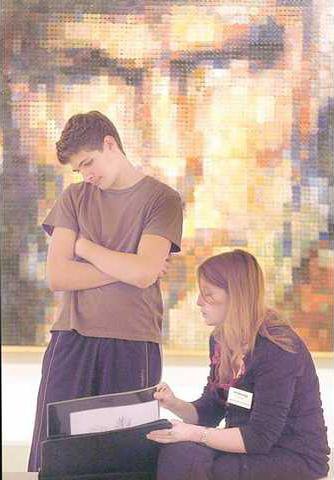Most high school seniors are preparing to study business, biology or literature in college. They're busy taking college entrance exams and writing essays for college applications.
But Hillary Harper, a senior at North Hall High School, hopes to study fashion or graphic design in college and has discovered that artists prepare for art school much differently.
Instead of showcasing test scores and essays to gain entrance into college, she's working on developing her art portfolio, the only window through which college admissions personnel have to view the talent of a young artist.
Harper said she's applying to top art schools such as The Fashion Institute of Design and Merchandising in California, Savannah College of Art and Design, Johnson & Wales University in North Carolina and the Art Institute of Atlanta.
While in the midst of taking the SAT and applying to schools, Harper said it's building her portfolio that is the last and most difficult piece of the application puzzle.
"You can keep producing and keep producing (art), but it's really hard to produce quality work," she said.
Harper was one of nearly a dozen students who attended a presentation at the Quinlan Visual Arts Center this month in which a SCAD admissions representative gave art students advice on how to build a winning portfolio.
Maya Rivera, an admissions representative for SCAD, said the best tip for high school artists is to start taking art classes as early as possible and to create works often.
A visual artist's portfolio should contain 10 to 20 of his or her best pieces. She said an artist's portfolio is only as good as the weakest piece.
"Developing a portfolio is important because it encourages artistic growth," Rivera said. "Create as much as you can in high school so you have much to edit from during the middle of your senior year in high school."
Rivera advised students to work from observation whenever possible, and draw on daily events to inspire creations. She said be sure to take into account composition, shading, lighting and spatial perception when painting, drawing, designing or taking photos.
"Think about your palette and the mood it evokes," she said. "Have you mixed your colors thoughtfully or did you use the paint straight out of the tube? Same with photography. Use lighting to evoke a mood."
Above all, she said, be original; don't "borrow" from others' works.
"Putting your artistic fingerprint on a piece makes your artwork stand out to a viewer," Rivera said. "Think about the person who's sitting down and looking through this stack of portfolios and think about what will stand out to them. What will interest them?
"What a lot of schools want to see is your own aesthetic awareness," she said. "Are you responding to the aesthetic world around you?"
Joe Emery, an art teacher at Gainesville High School, said college admissions counselors appreciate a student who can create from a variety of mediums, such as ceramics, painting, drawing and contoured drawing.
"One of the things they like to see is a self portrait," Emery said. "They like to see a lot of different medias, not just that they can draw."
If an artist is having trouble determining which pieces to use in a portfolio, Rivera suggested they ask peers, parents and especially art teachers for advice on which works to select. Line pieces against a wall and stand at a distance to hone down the collection until it includes only its strongest pieces, she said.
Rivera said some colleges encourage high school students to bring their art to the college for productive critique sessions during students' on-campus visits.
Peruse art magazines, visit art galleries, see as much art as you can to develop your own discriminating eye, she said.
Once pieces have been selected, students shouldn't forget to present them in their portfolio in a professional manner. Rivera said it's a good idea to crop and mount images for a sleek appearance. Select borders for art carefully so they don't distract from the piece but enhance it. Try unusual angles to view an art subject and fill the frame of the piece to keep it tight and focused.
She said when photographing a piece for a digital portfolio, be sure to crop out the wall behind the painting and make sure the photo is a clear, in-focus representation of your work.
"Presentation is like you're visual interview," Rivera said.
When submitting your work for admissions counselors to review, Rivera said SCAD counselors prefer students to submit portfolios on CD-ROMs or DVDs. It's also a good idea to include an inventory sheet describing the mediums and actual proportions of each piece, she said.
Including magazine or newspaper articles published about your works are also a plus, she said.
Rivera encouraged students to delve into their own ideas to produce art that will win them college acceptance letters.
"Your artistic fingerprint counts," she said.

